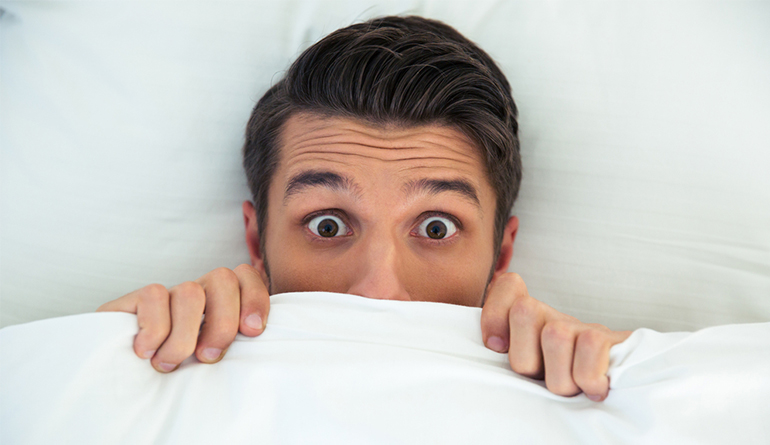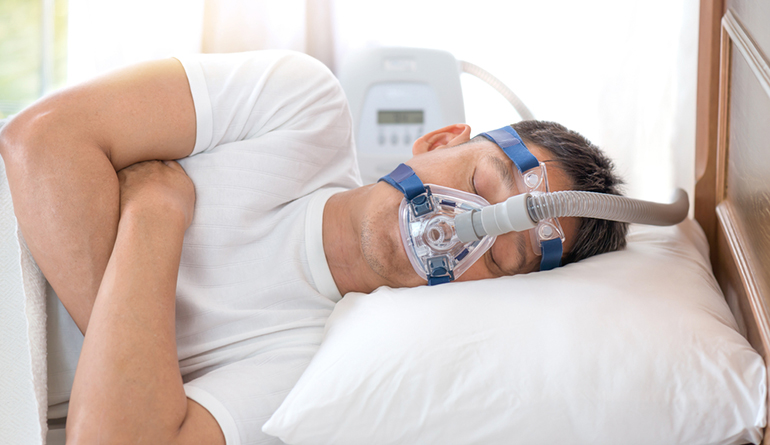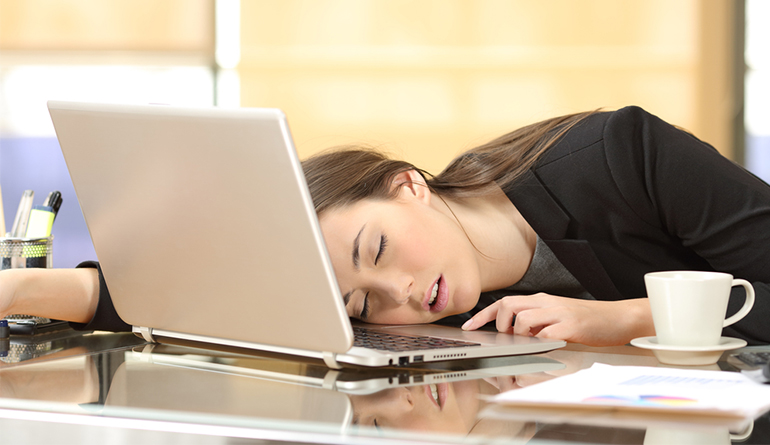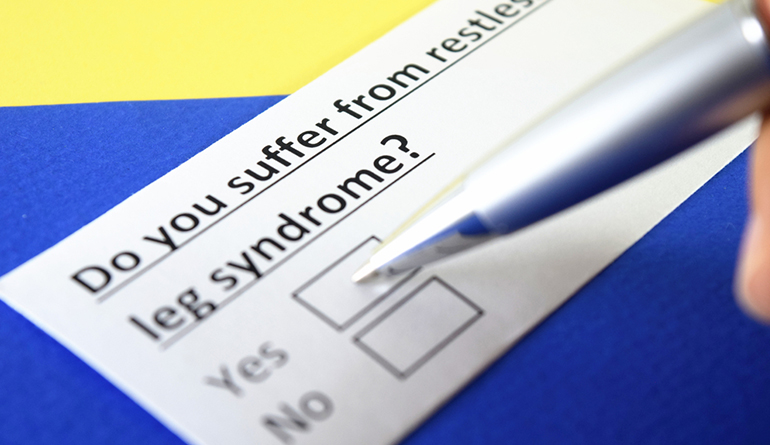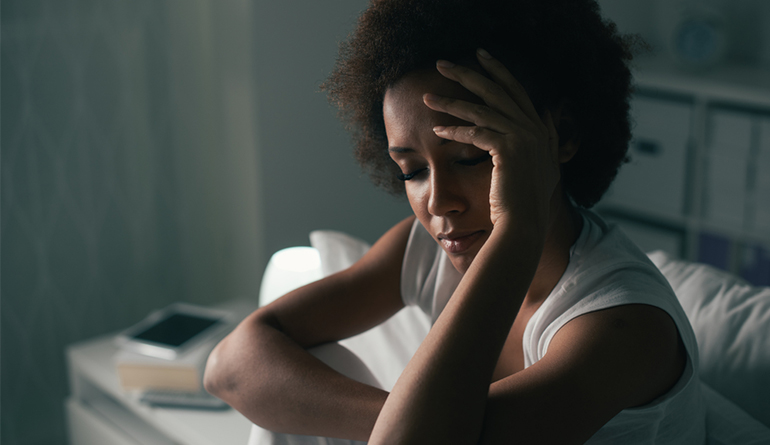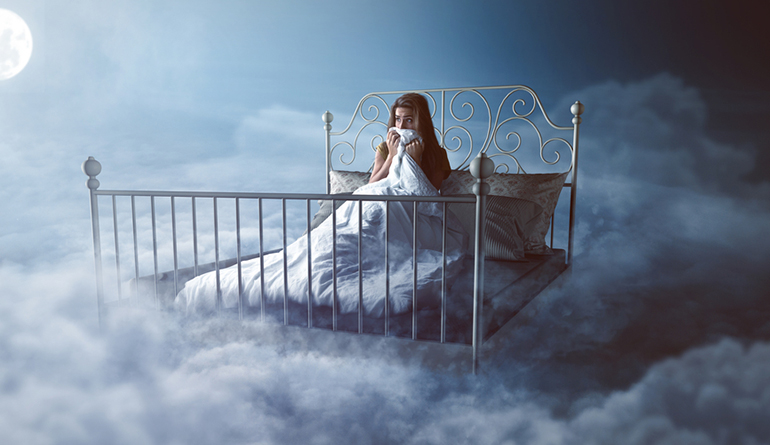Move over, Freddy Krueger. Real-life sleep disorders are giving people nightmares—and worse!
From sleepwalking and sleep violence to life-threatening Sudden Unexplained Death Syndrome, we at Pillow Picker have compiled a list of 20 scary sleep disorders that are sure to freak you out.
Some are freakishly common, while others are surprisingly rare.
One of the most unsettling truths about the following list is the fact that so many sleep disorders are unexplained despite extensive research.
The same can be said for treatment options; symptoms can be managed for many of the disorders, but there are very few that can be cured.
Read on, if you dare. These frightening sleep disorders are scarier than any Hollywood horror movie.
1) Obstructive Sleep Apnea
What it is: During sleep, Obstructive Sleep Apnea causes breathing to stop and start intermittently. Many people with this sleep disorder snore.
What causes it: Obstructive Sleep Apnea causes the throat muscles to relax, blocking the airway. Breathing often slows or stops for 10 to 20 seconds, causing oxygen levels to lower and a buildup of carbon dioxide. The brain then kicks into gear and nudges the sufferer awake to re-open the airway. Some individuals wake abruptly with shortness of breath, gasping, or choking. Others don’t even realize they wake up.
Obstructive Sleep Apnea can wreak havoc on overall health. The sleep/wake process occurs anywhere from 5 to 30 times per hours, according to the Mayo Clinic. Because of this, sufferers often don’t get adequate or restful sleep, making them increasingly tired throughout the day.
How to treat it: If you suspect you may have Obstructive Sleep Apnea, tell your doctor right away. He or she may refer you to a sleep specialist for evaluation. Lifestyle changes can help the condition; your doctor may recommend weight loss, regular exercise, or a nasal decongestant and/or allergy medication. Patients with Obstructive Sleep Apnea should quit smoking and avoid sleeping on their backs.
Therapies for the disorder include a positive airway pressure machine (CPAP), which helps to keep the airway open. Mouthpieces are an option for folks who struggle to sleep with a CPAP machine. As a last resort, some physicians may recommend surgery to remove tissue, or to implant an airway stimulation device, reset the jaw, or make an opening in the neck.
2) Hypersomnia
What it is: If you suffer from Hypersomnia, you struggle with excessive daytime tiredness, or you spend a large portion of your time asleep. Characteristics include falling asleep easily throughout the day—sometimes in inappropriate places—lacking energy, and trouble thinking.
What causes it: Other sleep disorders have been linked to Hypersomnia, including narcolepsy and sleep apnea. Sleep deprivation, obesity, drug and alcohol abuse, and/or genetics are also common factors in Hypersomnia.
How to treat it: Tell your physician about any daytime or nighttime symptoms you may be experiencing, including excessive sleepiness and the time you spend asleep and awake. He or she may recommend keeping a detailed sleep log, and you may be referred to a sleep specialist for a sleep study. In some cases, a CPAP machine is used to deliver continuous air through a mask.
3) REM Behavior Disorder
What it is: REM Behavior Disorder (RBD) is essentially acting out dreams during REM sleep. Sufferers may move their arms and legs, or even get up and take part in normal daytime activities while sleeping. Many shout, talk, or scream, and some even hit and punch others (sleep violence). Injuries to oneself or a partner have been reported during episodes.
What causes it: During REM sleep, nerve pathways in the brain cause temporary muscle paralysis, which keeps our sleeping bodies from acting out our dreams. This is not the case for those with REM Behavior Disorder. Because the pathways do not work effectively, sufferers often kick, hit, and act out their dreams.
How to treat it: If your doctor suspects you may have REM Behavior Disorder, he or she will conduct a physical and neurological exam. In some cases, sufferers may have more than one sleep disorder. Your physician may ask your bedpartner about your behavior during sleep. A sleep study may also be conducted to determine if you have the disorder.
Physical safeguards and medications are often used to treat REM Behavior Disorder. You may be encouraged to create a safe sleeping environment free from sharp objects, and to keep the area clutter-free. Some doctors prescribe over-the-counter melatonin or prescription medications to help with symptoms.
4) Night Terrors
What it is: Night terrors, otherwise known as sleep terrors, involve screaming, flailing in one’s sleep, and episodes of intense fear. Many individuals who suffer with night terrors also sleepwalk. Night terrors generally last anywhere from a few seconds to a few minutes, or sometimes even longer. The condition affects approximately 40 percent of children, according to the Mayo Clinic. However, most children outgrow the disorder by the time they are teens.
What causes it: Night terrors occur during deep, non-REM sleep. People who are sleep-deprived, extremely tired, stressed, traveling, or those with a fever may experience night terrors. Other factors include sleep-disordered breathing, restless leg syndrome, depression, anxiety, medications, and use of alcohol. Night terrors are more prevalent in individuals with a family history of night terrors or sleepwalking. Sufferers often experience daytime tiredness, disturbed sleep patterns, and injuries have been reported.
How to treat it: A physical exam and sleep study may be conducted to determine if you are experiencing night terrors and/or other sleep conditions. While treatment isn’t always necessary, many physicians will encourage sufferers to put physical safeguards in place, and to avoid stressors, including anxiety-inducing situations and extreme sleepiness. Your doctor will likely treat any underlying conditions that could be contributing to the night terrors. In some cases, anticipatory waking (waking the person 15 minutes before an episode typically occurs) or medications may be used.
5) Sexsomnia
What it is: Those suffering from Sexsomnia engage in sexual acts during sleep. Events typically occur during the deepest sleep cycle. People who experience sexual dreams do not necessarily have Sexsomnia. It’s the physical act that characterizes the disorder.
What causes it: In sexsominia, when the brain is transitioning between deep sleep cycles, there is a disruption. Lifestyle habits and medication may contribute to the disorder, as well as lack of sleep, tiredness, drug or alcohol use, stress, anxiety, shift work and travel. The disorder has been linked to Obstructive Sleep Apnea, though a main cause has not been determined.
How to treat it: If you suffer with sexsomnia, your doctor will likely recommend maintaining a regular sleep schedule. Therapies include the use of a CPAP machine and/or medication. Many sufferers also benefit from therapy, as sexsomnia often causes feelings of embarrassment or shame.
6) Narcolepsy
What it is: Individuals suffering with narcolepsy experience overwhelming tiredness during waking hours and sudden sleep attacks. Many individuals with this disorder fall asleep multiple times throughout the day with no warning. Sufferers experience a sudden loss of muscle tone (called cataplexy), which can cause loss of muscle control and/or weakness. According to the Mayo Clinic, cataplexy often follows a strong emotional response, such as laughter.
What causes it: While there is no known cause, multiple factors may contribute to narcolepsy. Many sufferers have low levels of the brain chemical hypocretin, which regulates the sleep/wake cycle. Those with a family history of narcolepsy may also be at risk.
How to treat it: If you think you may have narcolepsy, your doctor may ask you to keep a detailed sleep log. A sleep study may also be beneficial. Unfortunately, there’s no cure for the disorder. Certain stimulant, antidepressant, and SSRI medications may be prescribed, and coexisting conditions will likely be addressed.
7) Sleepwalking
What it is: Individuals who sleepwalk often walk or perform other acts in their sleep. Considered a behavior disorder, sleepwalking occurs much more often in children than in adults. In addition to walking, sleepwalkers may take part in other complex activities. Some individuals even leave the house and/or drive during episodes. Contrary to popular belief, it is best to wake a sleepwalker to avoid any accidents or injuries. People who sleepwalk are difficult to arouse and rarely remember the event.
What causes it: Genetics may play a role in sleepwalking, though there is no known cause. Those who are sleep deprived or stressed, drink alcohol, have certain medical conditions or take certain medications are at higher risk. Children typically outgrow the disorder; it’s most prevalent in those between three and seven, according to the National Sleep Foundation.
How to treat it: While there is no cure for sleepwalking, your physician will likely encourage you to practice good sleep hygiene, including a regular bedtime routine, and consistent sleep times and wake times. Hypnosis is sometimes recommended, and antidepressant medication is often prescribed.
8) Restless Leg Syndrome
What it is: People with Restless Leg Syndrome (RLS) experience an uncontrollable urge to move their legs. This is typically due to an unpleasant sensation. Sufferers often experience symptoms in the evening or at night while trying to relax or sleep. Many people with RLS report sleep problems, which leads to daytime fatigue. Movement offers temporary relief in most people.
What causes it: The cause for RLS is largely unknown. Sufferers may have an imbalance of dopamine—the brain chemical that controls muscle movement. Genetics can play a role; RLS has been known to run in families. Pregnant women may experience RLS during the later stages of their pregnancy. Peripheral neuropathy, iron deficiency, kidney failure, and spinal cord conditions have also been linked to RLS.
How to treat it: RLS is often not difficult to diagnose. Your physician may first opt to treat any underlying conditions, such as an iron deficiency. Lifestyle changes and medications may be implemented to help with symptoms. Determining the right medication(s) for you may involve trial and error.
9) Sleep Paralysis
What it is: Those suffering with Sleep Paralysis are unable to move their bodies while falling asleep or waking up from sleep. The brain sends messages to the body to relax during sleep. This process is known as “atonia.” People with Sleep Paralysis experience atonia when awake. An episode may result in the individual being unable to move the head or limbs. Speech can also be affected. Typically, the person is aware of the episode, which can last anywhere from a few seconds to several minutes.
What causes it: Genetics may play a role in Sleep Paralysis. It can affect people of any age, and it typically begins between ages 14 and 17. While there is no known cause, it has been linked to extreme tiredness, sleeping on the back, a change in sleep schedule, bipolar disorder, the use of some medications, and leg cramps during sleep.
How to treat it: Most physicians will take a medical history and family history to diagnose the disorder. Often, no tests are necessary, but some doctors will order a sleep study to observe brain activity, breathing, and heart rate. Practice good sleep hygiene, and be sure to mention any co-existing medical conditions to your doctor, including mental health concerns.
10) Exploding Head Syndrome
What it is: If you suffer from Exploding Head Syndrome, you likely imagine a loud noise in your head as you’re falling asleep or when you wake up in the middle of the night. It may sounds like cymbals clanging or a bomb exploding in your head. Exploding Head Syndrome tends to cause extreme stress and fear in sufferers. Some people experience events on occasion, while others have multiple episodes each night. Other characteristics include a flash of light, a muscle jerk, or a sudden pain in the head. However, episodes are generally painless.
What causes it: There is no known cause for Exploding Head Syndrome, though many people experience it during times of stress or extreme tiredness. Co-existing sleep disorders may occur. Those with mental health conditions, and those who take certain medications or drink alcohol, may be at risk.
How to treat it: If you are experiencing Exploding Head Syndrome symptoms, contact your physician or a sleep specialist. An overnight sleep study may be conducted, though the disorder can often be diagnosed without complex tests. Your physician will likely encourage good sleep hygiene and relaxation techniques for stress management. In some cases, prescription medications are also prescribed.
11) Insomnia
What it is: Those dealing with insomnia have a difficult time falling or staying asleep. Many sufferers wake up in the middle of the night and are unable to go back to sleep. This sleep disorder often causes daytime drowsiness and can lead to negative health consequences. Many sufferers never feel rested and experience irritability, depression, and/or anxiety. It may also be difficult to focus, recall events or important information. Increased errors and accidents have also been reported.
What causes it: Chronic insomnia may be the result of stress, life events, or lifestyle habits. Poor sleep hygiene, a varying sleep schedule, or evening/late night eating may cause the inability to fall or stay asleep. Treating co-existing medical conditions and cutting back or eliminating coffee and other stimulants may help. Insomnia affects people of all ages, but it tends to increase with age. Women, people over 60, and those with a mental or physical health condition are at greater risk.
How to treat it: If you’re struggling with insomnia, your doctor will likely conduct a physical exam and enquire about your sleep habits. He or she may also recommend a sleep study. Treating any underlying health conditions and practicing good sleep hygiene is the general course of action. Cognitive Behavioral Therapy specifically for insomnia may also be recommended. Some doctors will prescribe over-the-counter sleep aids, natural supplements, or prescription medications.
12) Kleine-Levin Syndrome
What it is: People with Kleine-Levin Syndrome (KLS) experience recurring periods of excessive sleep. Their behavior is altered, and they struggle to understand the world around them. Many times, sufferers only wake to eat or use the restroom. The episodes can last anywhere from a few days to months. Affected individuals cannot resume normal activities or care for themselves. In the media, the neurological disorder is sometimes dubbed “Sleeping Beauty Syndrome.” Between episodes, KLS sufferers function normally.
What causes it: It is unknown what causes KLS. Flu-like symptoms may be present. The onset is typically abrupt, and sufferers may experience depression as a result of their KLS symptoms. Adolescent males are at the highest risk, with 70 percent of sufferers being males.
How to treat it: Unfortunately, there is no treatment for KLS. Stimulant medications may be used for tiredness, but will not improve cognitive function. Episodes tend to decrease both in intensity and frequency over a period of 8 to 12 years.
13) Fatal Familial Insomnia
What it is: Individuals who experience Fatal Familial Insomnia (FFI) suffer from insomnia. This rare sleep disorder runs in families, and can also cause problems with speech, as well as dementia. FFI affects the brain’s thalamus, which controls emotional expression and sleep. The disorder generally results in death within a year or two of onset. Besides insomnia, symptoms include muscle spasms and stiffness, kicking while sleeping, and loss of appetite. At the later stages of the illness, cognitive functions decline, blood pressure and heart rate increase, and sufferers experience excessive sweating, trouble swallowing and/or speaking, fever, and unexplained weight loss.
What causes it: According to Healthline.com, FFI is caused by a mutation of the PRNP gene. “This mutation causes an attack on the thalamus, which controls your sleep cycles and allows different parts of your brain to communicate with each other,” the site explains. The thalamus begins losing nerve cells, leading to the unpleasant symptoms listed above.
How to treat it: If you suspect you are suffering from FFI, contact your physician right away. He or she will likely recommend keeping a detailed sleep log, A sleep study may also be conducted, and a PET scan might be ordered to determine thalamus function. Genetic testing can help to confirm the condition. Sadly, there’s no cure for FFI, but there are treatments available for managing symptoms, including medications.
14) Nightmare Disorder
What it is: Those with Nightmare Disorder experience disturbing dreams often. These “bad dreams” tend to result in a feeling of fear or anxiety, disrupt sleep, and impact daytime functioning. Nightmares are often vivid and disturbing, cause negative emotions, and keep sufferers from falling back to sleep. Individuals with this disorder may have difficulty functioning at work or school and may fear going to sleep.
What causes it: As with many sleep disorders, Nightmare Disorder is referred to as a parasomnia, which is a sleep disorder that is characterized by undesirable experiences before or during sleep, or upon waking. It is unclear what causes nightmares and Nightmare Disorder. Triggers may include stress, anxiety, extreme tiredness, trauma, certain medications, alcohol or drug use, co-existing conditions, and fear-inducing books or movies.
How to treat it: If you’re experiencing nightmares and you think you may have Nightmare Disorder, discuss your symptoms with your physician. He or she will likely conduct a physical evaluation. A sleep study may also be recommended. Underlying medical conditions will be addressed, and stress/anxiety treatment may be recommended. In some cases, medication is prescribed.
15) Sleep Hallucinations
What it is: People suffering from Sleep Hallucinations imagine events that appear to be real. These events are generally visual, but they can involve all five senses. These hallucinations typically occur at the onset of sleep or upon waking. People who experience Sleep Hallucinations during the day may also have Narcolepsy.
What causes it: While the exact cause of Sleep Hallucinations is unknown, they can be triggered by the following: alcohol or drug use, stress and/or anxiety, mood disorders, and/or insomnia. Epileptic seizures can also cause Sleep Hallucinations.
How to treat it: If you are experiencing Sleep Hallucinations, make your doctor aware of your symptoms and co-existing medical conditions. He or she may ask you to keep a detailed sleep log, and a sleep study may be recommended. Good sleep hygiene, adequate rest, and eliminating alcohol can help alleviate symptoms.
16) Nocturnal Sleep-Related Eating Disorder
What it is: Those with Nocturnal Sleep-Related Eating Disorder (NS-RED) eat during sleep. Sufferers prepare and consume food, but don’t recall the episode upon waking. People with NS-RED are often not hungry for breakfast, eat more than half of their daily food intake after an evening meal, and often wake up in the middle of the night and are unable to fall back to sleep unless they eat. This disorder can lead to weight gain, shame, and depression.
What causes it: A definite cause for NS-RED is unknown, though daytime dieters have been known to binge-eat at night. Those with co-existing eating disorders are at a higher risk.
How to treat it: If you’re suffering from NS-RED, your doctor will go over your medical history and may order a sleep study. In some cases, counseling and/or medication is recommended, as well as activities that relieve anxiety and stress.
17) Sleep Bruxism
What it is: Folks with Sleep Bruxism clench or grind their teeth during sleep. Individuals with this disorder are likely to have other sleep disorders, like snoring or sleep apnea. Bruxism can lead to serious health complications, such as headaches, jaw disorders, and damaged teeth. Some people with Sleep Bruxism are unware of the problem.
What causes it: Daytime Bruxism has been associated with stress, anxiety, and tension. Sleep Bruxism could be a chewing activity linked to arousal, according to the Mayo Clinic. People with a family history of Bruxism are at risk, as are young children, and people with co-existing medical conditions, such as dementia, Parkinson’s disease, and other sleep disorders.
How to treat it: If you think you may have Bruxism, contact your dentist. He or she will examine you for signs of the condition and may order a sleep study. Treatment isn’t necessary in most cases, but those with severe Bruxism may need a splint or mouth guard to separate teeth and prevent damage. Dental correction will be considered for severe cases. Co-existing sleep disorders should be addressed by a physician, as well.
18) Nocturnal Paroxysmal Dystonia
What it is: People suffering from Nocturnal Paroxysmal Dystonia (NPD) experience recurrent attacks during non-REM sleep. These attacks can last from seconds to several minutes. Movements are characterized as ballistic and involve the limbs and the neck.
What causes it: According to a 2013 study, most individuals with NPD have a type of sleep-activated focal epilepsy. The study concluded that the NPD-related attacks were caused by nocturnal frontal lobe epilepsy.
How to treat it: While studies have been conducted to determine the causes of NPD, conclusive information regarding diagnosis and treatment are still being researched.
19) Non-24-Hour Sleep Wake Disorder
What it is: Individuals with Non-24 Hour Sleep Wake Disorder (Non-24) experience a disruption in the 24-hour synchronization of the normal circadian rhythms. According to WebMD, the internal clock “is not synched with light and dark cycles of the day and night.” People with Non-24 often feel tired during the day and are wide awake at night.
What causes it: Most people with Non-24 are blind, and light isn’t able to get to the brain. This can cause a change in the body’s internal clock. People lacking melatonin could also be at risk. Those with brain damage are at risk, as are individuals with developmental brain disorders.
How to treat it: Go over your complete medical history with your doctor if you believe you may have Non-24. Your doctor will likely ask questions about your sleep hygiene and symptoms. A light box can be used to expose the brain to light. Melatonin and prescription medications may also be effective.
20) Sudden Unexplained Death Syndrome
What it is: People with Sudden Unexplained Death Syndrome (SUDS) unexpectedly die in their sleep. This rare disorder can affect adolescents and adults, and has been reported in Southeast Asia and other Asian populations.
What causes it: SUDS has been linked to Brugada Syndrome, a condition which causes electrical activity in the heart. This syndrome increases the chance of sudden cardiac death, and it’s more likely to attack when a person is resting. There is no definite cause reported, but those with certain heart conditions are thought to be at higher risk.
How to treat it: The only known treatment for SUDS is to implant a cardioverter-defibrillator (ICD), which helps to pace the heart.
As you can see, sleep disorders can be life altering, and in some cases, life threatening. If you are experiencing sleep problems, it’s important to visit your doctor right away. Be prepared by jotting down your symptoms, your sleep patterns (including any recent changes), and any questions you may have. As mentioned above, there are often co-existing medical conditions that can be addressed, which can help to alleviate symptoms.
Be your own advocate, and most importantly, don’t give up! Sleep disorders may be scary, but they don’t have to rule your life.
Resources used:
https://www.mayoclinic.org/diseases-conditions/obstructive-sleep-apnea/symptoms-causes/syc-20352090
https://sleepfoundation.org/sleep-disorders-problems/rem-behavior-disorder
https://www.mayoclinic.org/diseases-conditions/sleep-terrors/symptoms-causes/syc-20353524
https://www.medicalnewstoday.com/articles/320448.php
https://sleepfoundation.org/sleep-disorders-problems/abnormal-sleep-behaviors/sleepwalking
https://www.mayoclinic.org/diseases-conditions/restless-legs-syndrome/symptoms-causes/syc-20377168
http://www.sleepeducation.org/sleep-disorders-by-category/parasomnias/sleep-paralysis/overview-facts
https://www.mayoclinic.org/diseases-conditions/insomnia/symptoms-causes/syc-20355167
https://klsfoundation.org/what-is-kleine-levin-syndrome/
https://www.healthline.com/health/fatal-familial-insomnia
https://en.wikipedia.org/wiki/Sudden_arrhythmic_death_syndrome
https://en.wikipedia.org/wiki/Brugada_syndrome
https://www.mayoclinic.org/diseases-conditions/nightmare-disorder/symptoms-causes/syc-20353515
https://www.sleep-journal.com/article/S1389-9457(13)01698-5/abstract
https://www.mayoclinic.org/diseases-conditions/bruxism/symptoms-causes/syc-20356095
https://www.webmd.com/sleep-disorders/guide/sleep-related-eating-disorders
https://sleepfoundation.org/non-24/content/facts-prevalence
https://www.webmd.com/sleep-disorders/non-24hour-sleep-wake-disorder#1

